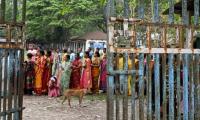Amidst a national reckoning with anti-Black racism and white supremacy throughout the United States, legacy media outlets have published highly problematic and dangerous articles on recent protests against police brutality.
Recent local coverage of protests in Detroit, which included a nonviolent march up Gratiot Ave. on the city’s East Side on Tuesday June 2, illustrates this national trend and plays directly into the hands of those who would prefer to see these protests squashed rather than succeed.
That Tuesday evening march proved to be a pivotal moment in Detroit’s swiftly evolving protest movement. Two days prior, Mayor Duggan had announced a citywide curfew of 8pm in response to what he described as “unruly crowds” that “threatened the safety” of police officers, the public, and property. The curfew became a point of conflict for organizers involved in the unfolding protests.
Those who encouraged protesters to follow the curfew to avoid police violence were praised by media and city officials. Others, like Tristan Taylor and Nakia-Renne Wallace, felt that to obey the curfew “would be signing on to another hundred years of excessive racism and police violence.” When the latter group resisted the curfew on June 2nd, their violent arrests by the Detroit Police Department proved to galvanize the movement.
The curfew had come amidst a flurry of media coverage and statements from city officials, police, and established civil rights leaders blaming unrest on outside agitators coming into the city and causing trouble. The presence and actions of white non-Detroiters in recent protests is a complex issue that is important to discuss and analyze. But to have that be the defining storyline resurrects well-worn racist tropes about outside agitators and marginalizes the anger and agency of Black Detroiters who have been in the streets mobilizing their righteous anger since day one.
History has shown us that the media plays a critical role during fast-moving periods of urban uprisings. In the days since the nationwide uprisings began, local media outlets have tried to drive a wedge between a protest movement against police brutality and systemic racism that has been unfolding in Detroit’s streets. A standard divide and conquer storyline defined much of the coverage of protests against the city’s curfew, pitting those who decided to engage in civil disobedience against those who chose to fall in line. This is the same kind of media coverage that was used in the 1960s to discredit Dr. Martin Luther King, Jr.’s strategy of engaging in direct action confrontations with those who upheld unjust laws.
Excerpted from: 'Policing Protest: the Dangers of Media Bias During Urban Uprisings'.
Counterpunch.org
A woman walks past a building of the International Monetary Fund. — AFP/FileThe annual and spring meetings of the...
Late Benazir Bhutto's daughter Asifa Bhutto Zardari addresses the Christian community in Bihar Colony on January 23,...
Representational image. — PexelsWater is an important scarce natural resource that is required for several everyday...
Pakistani employees of online marketplace company Kaymu at work in Karachi. — AFP/FileThe true spirit of development...
India uses Afghanistan as a backstage area to carry out terrorist attacks against Pakistan
Another report by the Pakistan Institute of Peace Studies states that 78 per cent of attacks have been carried out by...







